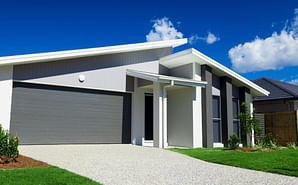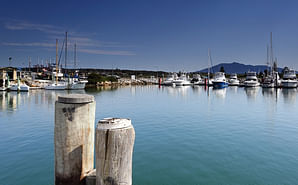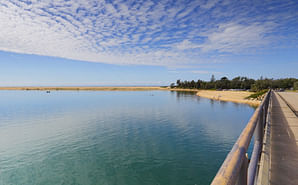Effluent management
Effluent is the final liquid product that is produced by and discharge from a sewage treatment plant (STP).
What is Effluent?
Effluent is the final liquid product that is produced by and discharged from a sewage treatment plant (STP). In the Bega Valley Shire, effluent is used to irrigate golf courses, playing fields, showgrounds and farms and the volume that isn’t reused is disposed to ocean, rivers, creeks and coastal dune aquifers, depending on the location of the STP and system of disposal. Effluent is also known as “recycled water” or “reclaimed water” when it is used beneficially. “Treated effluent” is another term used for effluent, to highlight that it has been treated to a high standard.
Effluent volume
The volume of effluent produced at each of the STPs in the Shire depends upon the number and types of properties connected to the sewerage system and the occupancy of those properties. The volume of sewage produced by a community is more or less the same as the volume of effluent produced by an STP after treatment. That is, the volume that flows in as sewage then flows out as effluent, less about 5% removed as sludge and by evaporation from aeration tanks and storages.
More effluent is produced during wet weather, due to stormwater inflow and infiltration into the sewerage system. Higher volumes of effluent are also produced during summer holiday periods, due to the high occupancy of holiday accommodation, particularly for the coastal STPs.
Shown right is the annual volume of effluent produced at each STP, averaged and rounded between 2007 and 2017. ML/y is megalitres (or millions of litres) per year.
Effluent quality
The quality of effluent produced at each STP in the Shire depends upon influent characteristics, the STP level of treatment and how the plant is operated.
Key parameters used to determine effluent quality are total suspended solids (TSS), biochemical oxygen demand (BOD), oil and grease (O&G), total nitrogen (TN), ammonia, total phosphorous (TP) and faecal coliforms (FC). EPA Environment Protection Licences (EPL) specify the quality that BVSC is required to achieve for these parameters.
Effluent quality data for each STP is available from the Effluent Quality at EPA Licensed Sewage Treatment Plants page on this website. The data on this page record effluent quality characteristics and assess the performance of each STP relative to its EPL limits.
Effluent management
The reuse and disposal locations for effluent produced at each STP are shown in the table below.
| STP | Effluent reuse | Effluent disposal |
|---|---|---|
| Eden (1) | Golf course | Ocean outfall |
| Merimbula (2) | Golf course | Ocean outfall and dunal exfiltration |
| Tura Beach (3) | Golf course | Dunal exfiltration |
| Tathra (4) | Golf course & football field | Golf Course overwatering |
| Bega (5) | No reuse since May 2013 | Bega River |
| Bermagui (6) | Golf course | Ocean outfall |
| Wolumla (7) | Football field, horse arena and farm | Overflow to farmers irrigation dam |
| Candelo (8) | Showground | Candelo Creek |
| Kalaru (9) | Racetrack | Overflow to racetrack dam |
| Cobargo (10) | Showground | Narira Creek |
The reuse component is highest in summer when the reuse areas have a soil moisture deficit and demand for effluent is higher. In winter, and during wet times, the effluent demand is low and the proportion of effluent disposal is higher.
Effluent storages are essential to maximise reuse and minimise the amount of effluent disposed. Off-stream dams and/or large tanks are used. However, it is often not possible to provide storages of sufficient capacity to store all of the effluent produced during times when irrigation cannot occur. Local topography, land availability, soil permeability requirements and other factors restrict the size of storages that can be built. Effluent unable to be stored and reused is disposed.
Potential public health and environmental issues associated with effluent reuse and disposal are managed through management systems which include monitoring, on-site controls, operational procedures, research, investigations, education and awareness and planned STP and reuse/disposal system upgrades, coordinated by the Water and Sewerage Services section of Council, in partnership with effluent users and other stakeholders like the EPA.






